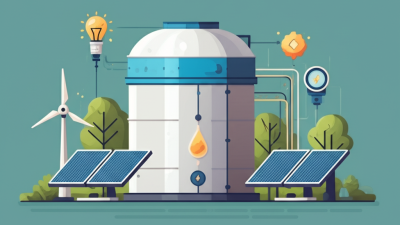The Ultimate Guide to Choosing the Best Plastic Storage Tanks for Your Needs
In the world of industrial storage solutions, plastic storage tanks have emerged as a versatile and cost-effective choice for various applications. According to a recent report by ResearchAndMarkets, the global plastic storage tanks market is expected to grow at a CAGR of 4.3% from 2021 to 2026, fueled by the increasing demand for safe and reliable storage systems across sectors such as agriculture, chemicals, and water treatment. As businesses strive to enhance operational efficiency while minimizing risks associated with corrosion and leaks, the right plastic storage tank can make all the difference.

Industry expert Dr. Emily Carter, a leading figure in materials engineering, emphasizes the importance of selecting the appropriate tank for specific needs, stating, "Choosing the right plastic storage tank is not just about capacity; it's about understanding the materials, installation requirements, and compliance regulations that govern your industry." This highlights the critical considerations that play a vital role in ensuring that the selected tank meets both operational and safety standards.
As you navigate the myriad options available in the market, this guide aims to streamline your decision-making process, focusing on the "Top 5" plastic storage tanks tailored to meet diverse requirements. From UV resistance to chemical compatibility, understanding these factors will empower you to make informed choices and ultimately enhance the longevity and effectiveness of your storage solutions.
Key Factors to Consider When Selecting Plastic Storage Tanks
When selecting plastic storage tanks, several key factors come into play to ensure you meet your specific needs. First and foremost, consider the type of material used in the tank's construction.
High-density polyethylene (HDPE) is a popular choice due to its durability, UV resistance, and chemical compatibility. Additionally, assess the tank's capacity based on the volume of liquid you need to store, keeping in mind any future expansions.
Another vital factor is the tank's design and accessibility features. Make sure to choose tanks with wide openings for easy filling and cleaning. Consider the tank's location as well; for outdoor settings, look for tanks that offer protection from environmental factors such as sunlight and extreme temperatures.
Tips: Always check for certifications to ensure the tank meets safety and environmental standards. Additionally, consider the tank's weight and handling features if you need to move or transport it frequently. Finally, evaluating the warranty and customer support can provide peace of mind and assistance in case of any issues after purchase.
Top 5 Types of Plastic Storage Tanks and Their Best Applications
When selecting the best plastic storage tanks for your needs, understanding the various types and their applications is crucial. There are five main types of plastic storage tanks: vertical tanks, horizontal tanks, open top tanks, double-wall tanks, and specialized tanks. Each type is designed to serve distinct purposes, making it essential for users to match the tank type with their specific requirements.
Vertical tanks are ideal for high-volume storage in limited spaces, commonly used for water and chemical storage. Horizontal tanks, on the other hand, are suitable for applications requiring ease of access and flexibility in placement. Open top tanks are perfect for processes like mixing and holding, especially in agricultural and industrial settings. Double-wall tanks provide an additional layer of safety, preventing leaks and environmental hazards, which is vital for hazardous materials. Lastly, specialized tanks cater to unique needs, such as those for food-grade applications or specific chemicals, ensuring that safety and compliance standards are met. Knowing these options allows you to make an informed choice that best supports your storage needs.
The Ultimate Guide to Choosing the Best Plastic Storage Tanks for Your Needs
| Type of Plastic Storage Tank | Material | Capacity Range | Best Applications | Key Features |
|---|---|---|---|---|
| Vertical Storage Tanks | HDPE | 50 - 10,000 gallons | Water, chemicals, and food storage | UV resistant, lightweight |
| Horizontal Storage Tanks | Polypropylene | 100 - 5,000 gallons | Liquid fertilizers, oils | Space-saving design, low profile |
| Cone Bottom Tanks | Linered polyethylene | 30 - 1,500 gallons | Mixing, brewing, and chemical applications | Easy drainage, robust design |
| Liquid Storage Tanks | FRP (Fiberglass Reinforced Plastic) | 500 - 20,000 gallons | Wastewater, chemicals | Corrosion-resistant, durable |
| Irrigation Tanks | Polyethylene | 300 - 10,000 gallons | Agricultural irrigation | Lightweight, anti-fade |
Essential Features to Look for in Durable Plastic Storage Tanks
When selecting a durable plastic storage tank, several essential features should be prioritized to ensure optimal performance and longevity. First and foremost, the material of the tank is crucial. Look for high-density polyethylene (HDPE) or polypropylene, as these materials are resistant to corrosion, UV rays, and various chemicals. This makes them suitable for storing a wide range of substances, from water to industrial liquids, without the risk of degradation.
Another key feature to consider is the tank's capacity and design. Assess your specific needs to determine the appropriate size, whether you require a small tank for residential use or a larger tank for commercial purposes. Additionally, the shape of the tank can influence its placement and ease of use. Opt for tanks with built-in handles or anchoring points for effortless transportation and secure installation. Lastly, ensure that the tank has adequate fittings and vents, as these can prevent pressure build-up and facilitate smooth flow, enhancing the overall efficiency of your storage solution.
Comparative Analysis: Vertical vs. Horizontal Plastic Storage Tanks
When choosing between vertical and horizontal plastic storage tanks, it's essential to consider factors like space availability, capacity needs, and environmental conditions. Vertical tanks occupy less ground space and can be more suitable for sites with limited area. They often have a smaller footprint and can be easier to transport and install. However, they can also experience different dynamic responses under various loads due to their height, which can impact their stability, particularly in case of soil-structure interactions during seismic events.
Conversely, horizontal tanks generally provide a more stable option against ground settlement and dynamic forces since they have a lower center of gravity. Their design can facilitate easier access for maintenance and cleaning. Additionally, the configuration of the inlet pipe can influence their ability to self-clean, especially in systems like recirculating aquaculture tanks. Understanding the implications of gas migration and ventilation conditions in horizontal tanks is also crucial in preventing accidents during confined space operations. Therefore, evaluating these characteristics is vital for selecting the appropriate tank type for your specific storage needs.
The Ultimate Guide to Choosing the Best Plastic Storage Tanks
This bar chart compares the capacity, durability, and cost of vertical and horizontal plastic storage tanks, helping you choose the best option for your needs.
Maintenance Tips for Prolonging the Life of Plastic Storage Tanks
Proper maintenance is essential for prolonging the life of plastic storage tanks, ensuring they remain functional and safe for use. Regular inspections should be conducted to look for signs of wear and tear, such as cracks, discoloration, or signs of leakage. It is important to clean the tanks periodically, using gentle cleaning solutions that won’t damage the plastic. Avoid using harsh chemicals that can degrade the material, as well as abrasive cleaning tools that may scratch the surface.
In addition to regular cleaning and inspection, proper storage conditions can significantly extend the life of plastic tanks. Keeping them away from direct sunlight is crucial, as UV rays can cause degradation over time. When possible, store tanks indoors or in shaded areas to minimize exposure. Moreover, ensuring that tanks are not overfilled and are positioned on stable surfaces will help to prevent strain and potential damage. Following these maintenance tips will help you maximize the lifespan of your plastic storage tanks and keep them functioning effectively for years to come.


